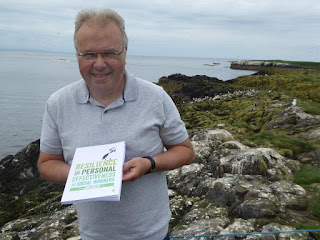I am
currently enjoying the excitement of showing people my first book Resilience and Personal Effectiveness for Social Workers, which has
just been published by Sage. I am very pleased with layout and cover design. It
was my desire to create a book which would be of practical help to people and
which would be easy to dip into. Good design is crucial for enabling people to
find the material which they need and understanding how the book is structured.
Good cover design is even more important because it affects people’s decision
about whether they take the book off the shelf or open it.
Fortunately,
Sage gave me a chance to have creative input in the cover design. I felt that
there were a lot of social work books with quite similar designs of tranquil
scenes such as hot air balloons or washing lines. I wanted something which
would stand out from the other books. I also wanted a design that would convey
the concept of personal agency- of social workers being in control of the
stress and pressures in their lives. For that reason I wanted a design which
showed an animal which would embody the qualities of resilience. Various ideas
were considered but none of them seemed right. A tortoise has resilience but it
shields itself from the world with a shell (while social workers need openness
and empathy) and moves slowly (the wrong message for a book which includes tips
on time management). Big cats are sleek and strong but they are also aggressive
and predatory – again the wrong message for social work.
Eventually
my wife suggested a puffin. These are birds which we have a lot of affection
for. Living in the north east near a major puffin colony on the Farne islands,
they are for us emblematic of our pride in the region. It is an eye catching
bird and its striped summer beak makes it look almost too exotic for the cold North
and Atlantic seas which puffins inhabit. Their cheery and slightly comical
appearance cries out in defiance of the freezing winds and rain which they have
to contend with. We always travel with a small toy puffin attached to our
rucksack and it often evokes curiosity in people in other countries, who assume
that it must hail from some tropical shore.
It quickly
became apparent to me that the puffin embodies many aspects of resilience. Puffins
are strong birds and beat their wings 400 times per minute to reach speeds of
over 80km per hour.They are long lived – some going into their thirties- the
type of longevity I would like people to have in their social work careers.
Puffins spend their first few years of life at sea- a feeling which will be
familiar to many newly qualified social workers. Like social workers, they are
social animals and live in colonies during the breeding season. They have
sophisticated non-verbal communication, for example adopting a ‘low profile’
head down walk to indicate they are not being threatening when crossing another
puffin’s territory. For social workers, understanding how organisations work
and building positive relationships with colleagues and managers is vital. My
book looks at how to make the most of the support which is available through supervision
and informal networks.
Puffins have
a progressive non-sexist approach to division of labour- they form long term
pair bonds and share in the tasks of building their burrow and in incubating
their eggs. My book looks at how to be a good team member and give support to
colleagues who need it.
Like social
workers, puffins are having to go through a period of change and adaptation to
prevailing conditions – in their case warming oceans as a result of climate
change. For social workers the threats involve political, economic and technological
changes such as privatisation. My book
addresses ways in which social workers can supercharge their CV to stay ahead
of a changing employment market and build a resilient career.
Sage created
a cover design with the puffin cheekily sitting on the top of the title
lettering. I thought it was a design which was eye catching and symbolised the
engaging, practical optimistic and sometimes irreverent style of the book
The aim of
the book is to equip social workers with a tool kit for dealing with the
emotional labour of social work and ideas for how to restore balance to their
working lives. The book uses exercises to help readers to explore how stress
affects them and to develop mindfulness
and improved work habits to address their own particular needs.
At the end
of July I decided to take a trip out to the Farne islands with my wife and a
copy of my newly arrived book. It was a
beautiful day and we saw lots of these amazing birds. They looked so perfectly
adapted for their island home and seemed to be living harmoniously as a colony.
The puffins didn’t seem to be interested in my book but I took lots of photos
of them and a few of myself with my book which Sage has so skilfully designed. It
was a pleasure to spend time with these amazing creatures and reflect on how
they embody so many of the qualities of resilience.
Here is Amazon link for my book https://www.amazon.co.uk/Resilience-Personal-Effectiveness-Social-Workers/dp/1473919177/ref=sr_1_sc_1?ie=UTF8&qid=1476461680&sr=8-1-spell&keywords=greer+resiience


